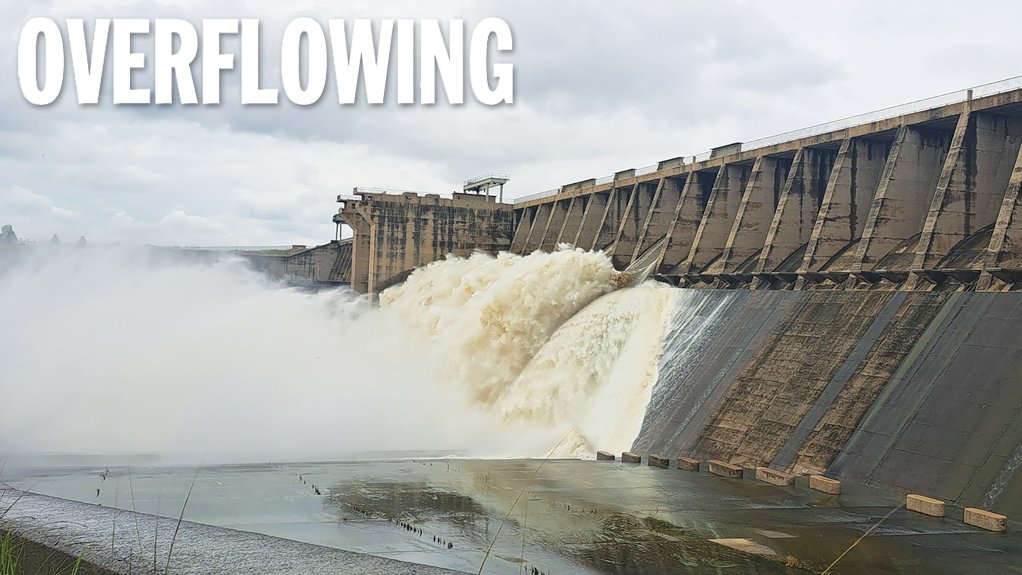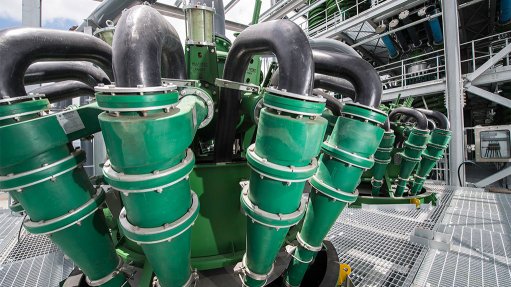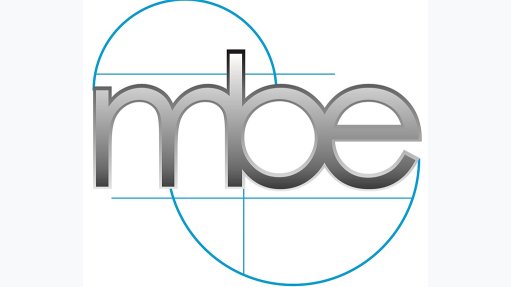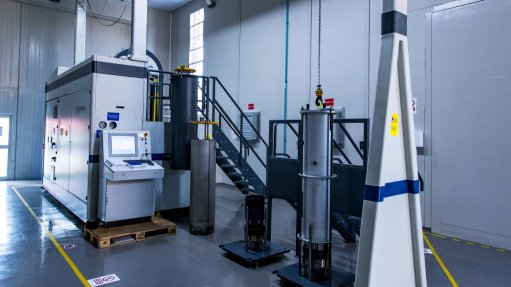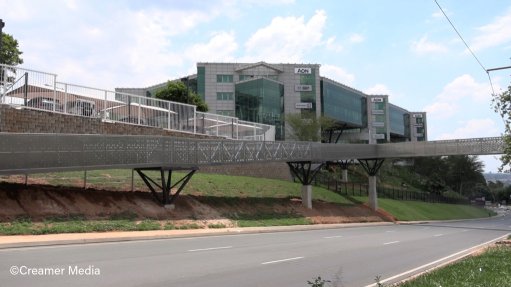From nearly empty six months ago, Vaal dam brims after heavy rains
In less than six months, the water storage level of South Africa’s Vaal dam surged from less than 30% capacity in December to overflowing, prompting the Department of Water and Sanitation (DWS) to open several sluice gates to relieve pressure on the dam.
By last month, the dam was full, with the DWS opening ten of its 60 sluice gates, resulting in an overflowing Vaal river and Bloemhof dam, as rainfall continued to put strain on the water catchment areas.
This followed concerns raised last year over the closure in October of the Lesotho Highlands Water Tunnel – which supplies water to the Integrated Vaal River System (IVRS) and, in effect, South Africa’s most populous province – for six months for maintenance. This move effectively stopped the flow of water from Lesotho to Gauteng.
The Vaal dam, a critical water resource for Gauteng and surrounding areas, has a total storage capacity of 2.57-billion cubic metres and a surface area of about 320 km2, making it a large but shallow reservoir.
As the months passed, the Vaal dam’s water level started decreasing at a rate of between 1.5% and 2% a week, with projections indicating that it would decline to 18% by December 23, 2024, owing to low inflows attributable to below-normal rainfall in the Vaal catchment and elevated temperatures that increased evaporation losses.
At the time, this prompted the DWS to prepare for the release of water from Sterkfontein dam, which had been filled as a contingency measure prior to the tunnel’s shutdown. The plan was to release water once the Vaal dam reached its 18% minimum operating level. However, the rains started before this measure became necessary.
Water volumes improved drastically, rising to over 50% by January 15 – from 24.3% in the preceding week. By March 7, the Vaal dam had reached 100% capacity, prompting the DWS to start releasing water slowly, initially through eight valves, to ensure balance between inflows and outflows.
Sustained rainfall across the catchment areas also brought stability to the IVRS, of which the Vaal dam forms a part, with the collective IVRS surface water storage of the 14 interconnected dams increasing from 87.7% a year ago and 71.6% at the start of December to 107.1% by April 28, according to data from the Gauteng Water Security Dashboard.
As part of the flood management plan, the DWS, from mid-March, started increasing the outflows of both the Vaal dam and the Bloemhof dam, which is located downstream of the Vaal river catchment, to prevent any catastrophic overflow and potential dam wall breaks.
On March 20, the valves were closed and one gate was opened at the Vaal dam, followed by a second gate on March 28.
In the first week of April, a total of five gates were opened, as the Vaal dam’s water level breached 109%.
By comparison, during April and May 2024, the Vaal dam’s water storage level was maintained at about 60%, according to data from water resource information centre Reservoir, which publishes daily hydrology updates on the Vaal barrage reservoir and the Vaal dam as provided by Rand Water and the DWS.
Following the temporary closure of three gates on April 15 and 16, in response to the then decreasing water level, the third gate was reopened on April 23.
On April 25, with inflows reaching 2 448.2 m3/s and the water storage level peaking at 121%, the number of open sluice gates was increased to ten, discharging 2 116.0 m3/s, with reports emerging of significant flooding around the banks of the Vaal river.
While the rainfall started when the dam’s water levels were low, worse flooding events could have occurred, with more sluice gates opened – and for longer periods – had the water level of the dam, as well as the other dams within the IVRS, been higher, the University of South Africa Department of Geography’s Associate Professor Anja du Plessis told Engineering News & Mining Weekly.
Other factors, such as the ground being saturated, for example, would also have influenced the outcome.
From April 30, the DWS started closing the first of the ten open sluice gates. By May 5, another sluice gate was closed, and two days later, only one gate remained open, as the water level reduced to 109.9%.
Similarly, on May 1, the DWS started decreasing the outflows from the Bloemhof dam, reaching a level of 800 m³/s by May 5. The DWS had increased outflows at the Bloemhof dam in a staggered manner throughout April, with peak discharge of 3 600 m3/s reached on April 28.
“With the immense rain which was received on a daily basis, with various variables changing consistently, the staff at the DWS did a good job under immense pressure to try and limit excessive losses, by managing both inflows (multiple tributaries) and outflows to ensure the integrity of the bulk water infrastructure and trying to limit major flooding in areas above certain floodlines,” she comments.
Regular Summer Occurrence
The Vaal dam’s sluice gates have been opened regularly over the years as part of the DWS’s water flow management strategy.
“This has not been a one-off occurrence, as we have been lucky to receive above- average rainfall over the past couple of years – where we also saw flooding of areas, especially within basic floodlines,” du Plessis says.
Data from the Reservoir information site shows that, during 2022, the DWS opened sluice gates at the Vaal dam on three occasions.
At the end of December 2021, two gates were opened when the Vaal dam breached 108.1%. The DWS maintained between two and five open gates during the next month, before all gates were closed at the end of January 2022. However, at the start of February 2022, one gate was reopened and remained open for three weeks as the dam levels stayed above 100%.
In April 2022, eight gates were opened in a staggered manner, until May 7, when all the gates were closed. By November 14 of that year, eight gates were again opened for a few days, before the number of gates opened to between one and five for a period of two months. All gates were finally closed by January 18, 2023.
Less than a month later, on February 12, the DWS opened one gate, gradually opening more until reaching 12 open sluice gates on February 19, 2023. The 12 gates were kept open until February 24, before the DWS started the gradual closing of the gates on March 9, 2023.
In 2024, no sluice gates were opened during the course of the year, as the dam’s water level averaged between 60% and 70% from January to May.
Responding to questions from Engineering New & Mining Weekly, the DWS said that the Vaal dam has 60 crest gates and eight valves for the controlled release of water. Each gate can release about 110 m3/s at 100% capacity and about 210 m3/s when the dam reaches 126% capacity.
There has only been one recorded instance when all 60 sluice gates – with a combined outflow of 2 590 m3/s – were opened. This occurred during flooding in 1975, when inflows reached 3 690 m3/s.
Following that event, the dam wall was raised by 2.77 m in 1985, a process that involved the replacement of the 3-m-high crest gates with 6.36 m crest gates. This was the second time the dam wall had been raised since the dam was built in 1938.
The first raising took place in the early 1950s, when the wall was increased by 6.1 m to ensure the supply of water amid a rapid expansion in industrial activity and the development of the Free State goldfields. This was also when the 60 crest gates, each 2.05 m high, were installed, according to the Water Research Commission publication, ‘In the Footsteps of Giants – Exploring the history of South Africa’s large dams’.
“Prior to 1985, the dam did not have such large flood absorption capacity,” the DWS points out, noting that, following the raising of the dam wall, there has been no documented case of all 60 gates having been opened simultaneously, even during the February 1996 flood, when the Vaal dam experienced peak inflows of 4 660 m³/s, which were reduced to 2 400 m3/s through gate operations and the use of flood absorption capacity.
The 20 radial gates at Bloemhof dam – which, for all practical purposes, has only about 50% of the storage capacity of the Vaal dam – have never been opened at the same time, even during the highest peak inflow on record of 6 300 m3/s experienced during March 1988. At the time, the maximum recorded outflow was 5 285 m3/s, the DWS adds.
At 100% capacity, each radial gate at the Bloemhof dam can release about 457 m3/s, increasing to about 555 m3/s at 118%.
During February 2010, the Bloemhof dam also experienced another of its highest recorded releases, discharging 3 685 m3/s, with the corresponding inflow reaching 4 030 m3/s.
A Cautious Decision
A decision to open any sluice gate at any time involves a carefully considered process.
The DWS tells Engineering News & Mining Weekly that, under normal circumstances, both the Vaal and Bloemhof dams are operated by their responsible operators in accordance with established operational rules.
However, when there are high flows into the Vaal river system, the National Hydrological Services steps in to provide technical guidance and coordinate the operations, as the Vaal-Orange River System spans four provinces.
The department explains that it has a network of monitored flow gauging stations in the Vaal river catchment.
Observed flood hydrographs are routed through the river system upstream of the Vaal dam using a Muskingum routing model to estimate the flood hydrograph that will ultimately enter the dam, following which the estimated flood hydrograph is routed through the dam using a level-pool-routing technique to estimate or forecast the water level expected at the dam wall.
The process is repeated two to three times a day with various release scenarios – such as when and how many gates open – to support decision-making on how to optimally absorb the flood hydrograph entering the dam and control the flood levels downstream, the department says.
“It is not just one dam’s inflows and outflows which have to be meticulously managed, but all dams within the Vaal- Orange system,” explains du Plessis.
It is a complex balancing act, with numerous and often-changing factors to consider. Opening too many sluice gates unnecessarily risks losing water which could otherwise be stored for the upcoming dry winter period.
“[Further,] it is imperative to ensure the integrity of our bulk water infrastructure, especially dam walls, as the consequences of not doing so . . . and a dam wall gets compromised – it will have disastrous impacts and consequences for the environment, the affected communities and the economy,” she continues.
Discussing the process involved when a decision is made to open a sluice gate, the DWS says that the dam operators are alerted, and the relevant information, along with any required early warnings, is disseminated through various channels, such as WhatsApp flood groups, to various stakeholders.
These stakeholders include water user associations, farming and community representatives and local authorities, and the general public through media releases published in mainstream media and on other platforms.
The DWS Disaster Management liaises with National and Provincial Disaster Management to activate evacuations (if and when necessary). The water releases are increased gradually to provide visible river-level cues and to allow the safe evacuation of livestock and movable assets.
A Critical Resource for Gauteng
The Lesotho Highlands water transfer tunnel, whose construction as part of Phase 1 of the Lesotho Highlands Water Project (LHWP) was completed in 2003, has been supplying Gauteng and surrounds with 780-million cubic metres of water a year.
However, on October 1, 2024, the tunnel was closed for a six-month maintenance project, overseen by the Lesotho Highlands Water Commission and jointly undertaken by the Lesotho Highlands Development Agency, the Trans-Caledon Tunnel Authority and various stakeholders.
It was initially expected to be completed by March 31, 2025; however, the DWS said that there is a further delay to the reopening of the LHWP tunnel. This has been caused by ever-changing weather patterns and the technical challenges experienced by the implementing agent on the Lesotho side of the tunnel. The maintenance work on the South African side has been completed.
Water was expected to be received by South Africa on May 16.
Meanwhile, the much-anticipated Phase II of the LHWP, which is expected to plug a significant water supply gap for Gauteng, will now only be completed by September 2029.
An oversight visit by the South African National Assembly’s Portfolio Committee on Water and Sanitation in February heard that the overall progress of Phase II stood at 48%, which was 8% behind the planned progress of 56% as at February.
The project’s water transfer and hydropower components were initially scheduled for commissioning by 2027 – already a year later than the initial plan.
Article Enquiry
Email Article
Save Article
Feedback
To advertise email advertising@creamermedia.co.za or click here
Comments
Press Office
Announcements
What's On
Subscribe to improve your user experience...
Option 1 (equivalent of R125 a month):
Receive a weekly copy of Creamer Media's Engineering News & Mining Weekly magazine
(print copy for those in South Africa and e-magazine for those outside of South Africa)
Receive daily email newsletters
Access to full search results
Access archive of magazine back copies
Access to Projects in Progress
Access to ONE Research Report of your choice in PDF format
Option 2 (equivalent of R375 a month):
All benefits from Option 1
PLUS
Access to Creamer Media's Research Channel Africa for ALL Research Reports, in PDF format, on various industrial and mining sectors
including Electricity; Water; Energy Transition; Hydrogen; Roads, Rail and Ports; Coal; Gold; Platinum; Battery Metals; etc.
Already a subscriber?
Forgotten your password?
Receive weekly copy of Creamer Media's Engineering News & Mining Weekly magazine (print copy for those in South Africa and e-magazine for those outside of South Africa)
➕
Recieve daily email newsletters
➕
Access to full search results
➕
Access archive of magazine back copies
➕
Access to Projects in Progress
➕
Access to ONE Research Report of your choice in PDF format
RESEARCH CHANNEL AFRICA
R4500 (equivalent of R375 a month)
SUBSCRIBEAll benefits from Option 1
➕
Access to Creamer Media's Research Channel Africa for ALL Research Reports on various industrial and mining sectors, in PDF format, including on:
Electricity
➕
Water
➕
Energy Transition
➕
Hydrogen
➕
Roads, Rail and Ports
➕
Coal
➕
Gold
➕
Platinum
➕
Battery Metals
➕
etc.
Receive all benefits from Option 1 or Option 2 delivered to numerous people at your company
➕
Multiple User names and Passwords for simultaneous log-ins
➕
Intranet integration access to all in your organisation



